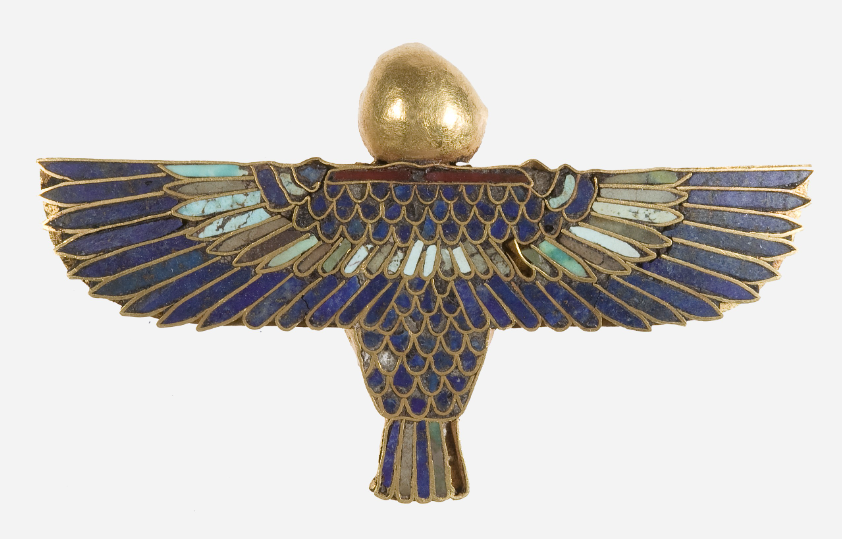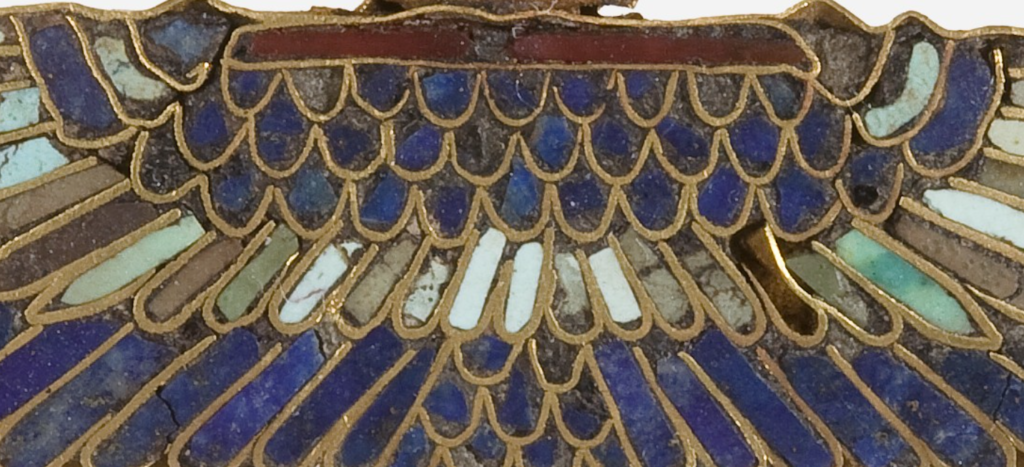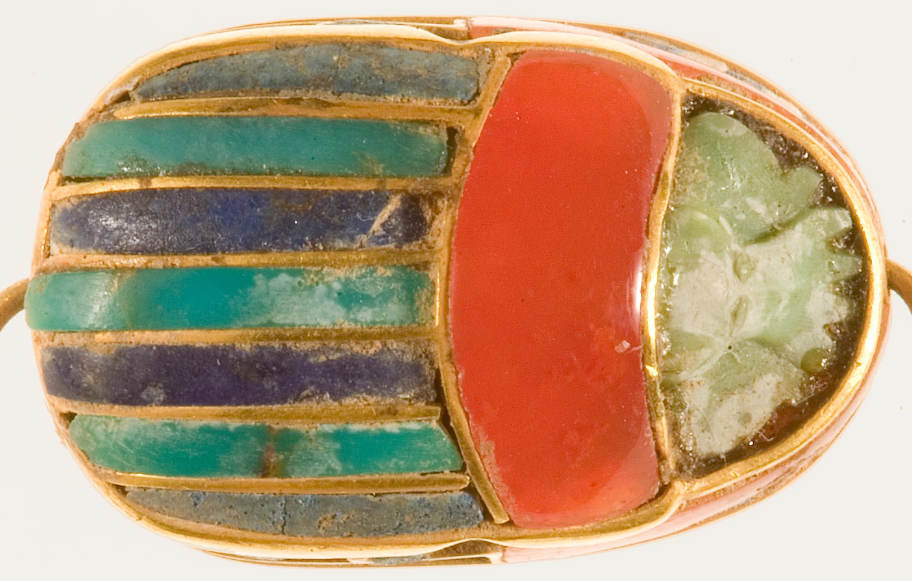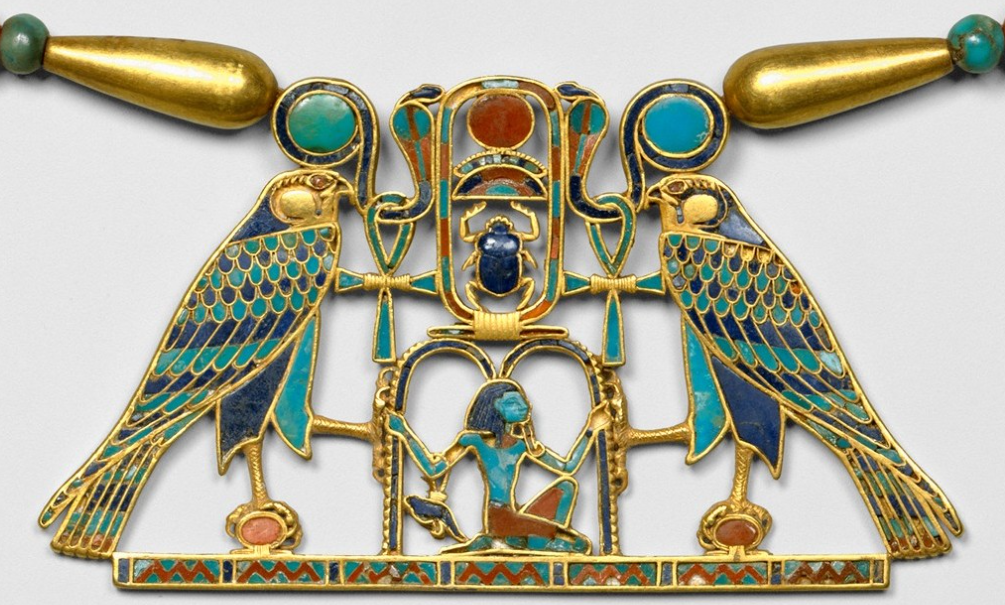“Turquoise is a blue-green copper-aluminum phosphate mineral much associated with ancient Egypt (15.3.205). Its English name, which has cognates in most European languages, probably derives from its association with Turkestan, a source of this semiprecious gemstone, or with the Turkish empire, an agent in its historic importation to the West. It is a relatively rare stone, mined today primarily in the American Southwest, Iran, and China; the sources of turquoise most easily available to the ancient Egyptians were in the southwest Sinai, from deposits that apparently were long ago substantially depleted. The most important ancient turquoise mines in the Sinai are found in two locations: Wadi Maghara and Serabit el-Khadim (05.4.259).
“Evidence of the exploitation of these mines includes mining tools and industrial installations for producing them, as well as habitation sites and numerous inscriptions relating to royal expeditions to the Sinai region during the third and second millennia B.C. At the latter, better-known site, a Middle Kingdom (ca. 2030–1650 B.C.) temple is dedicated to the goddess Hathor, who sometimes appears in texts with epithets naming her the lady or the mistress of turquoise.

A pendant depicting a ba-bird with outstretched wings

Pendant Detail
“In Egypt, the raw turquoise was fashioned into small objects, such as amulets and beads (31.6.25), and inlays that were mostly used on gold jewelry (13.184). It was also occasionally inlaid in stone, as on a charming figurine of a soft-shelled turtle (26.7.1359).
“The occurrence of turquoise increased greatly during the Middle Kingdom, presumably in tandem with renewed exploitation of the mines at Serabit el-Khadim. Turquoise is among the stones in a necklace found in the rich burial of a young girl named Myt dating to the second half of Dynasty 11 (22.3.324). She was buried in Deir el-Bahri within the funerary temple of Mentuhotep II, who reunited Upper and Lower Egypt at the beginning of the Middle Kingdom.
Scarab ring of Sithathoryunet

Scarab Ring Detail
“A favorite Egyptian color scheme was red, light blue-green, and dark blue; in lapidary work, these hues generally were represented by carnelian, turquoise, and lapis lazuli, respectively. This combination was particularly popular for cloisonné inlay jewelry of the Middle Kingdom. The pectoral of Sithathoryunet, a noblewoman buried in the pyramid of Senwosret II at Lahun, is a masterpiece of the genre (16.1.3a, b). The finest jewels and most lavish and highly valued semiprecious stones belonged to women with royal associations (16.1.24), but turquoise was also interred with less prominent, though presumably well-connected members of society: a gold and turquoise “upside down” catfish amulet, for instance, was found in a modest burial at Lisht during the 1908–9 season of the Museum’s Egyptian Expedition (09.180.1182). Turquoises often vary in color from geological specimen to specimen, and frequently an individual object includes unmatched stones. A Middle Kingdom cylinder amulet, for example, employs turquoise that ranges from blue to green to nearly yellow (26.7.1308), and the carved turquoise scarab head on a ring of Sithathoryunet is an unusual pale gray-green, while the inlays on the wings are a more conventional turquoise blue (16.1.24).
Stringing and Drilling Beads, Tomb of Rekhmire
Pectoral and Necklace of Sithathoryunet with the Name of Senwosret II

Necklace Detail
“The Sinai was likewise exploited for its more abundant copper ores, which is equally well attested in inscriptions and archaeological remains. Other major Old World sources of turquoise known to have been exploited in antiquity are located in central and northeastern Iran.
“Perhaps the earliest evidence of turquoise mining by local inhabitants of the Sinai comes from fragments of high-quality turquoise found in tombs in the el-Qaa region dated to around 5000 B.C. Somewhat later, during the Predynastic Period (4400–3100 B.C.), miners from the Nile valley arrived, although little turquoise from that time has been recovered in Egypt. During the Early Dynastic Period (ca. 3100–2649 B.C.) and Old Kingdom (ca. 2649–2130 B.C.), the exploitation of the mines at Serabit el-Khadim seems to have diminished, although evidence of mining at Wadi Maghara suggests that it continued there. Among the rare examples of turquoise dating to these periods are beads on several bracelets (Egyptian Museum, Cairo), found on the arm of an unidentified woman buried in the tomb of the Dynasty 1 king Djer at Abydos and on the broad collar of an important Dynasty 6 official named Impy (Museum of Fine Arts, Boston), from his burial at Giza.
“Although turquoise is closely linked with Egyptian culture in scholarly and popular perceptions, it was, in fact, a rare commodity in ancient Egypt. Its light blue-green color, associated with fertility and vegetation, was greatly valued. Other blue-green semiprecious stones, principally green feldspar (sometimes known in earlier literature as amazonite), and vitreous materials such as faience (23.3.244), glazed steatite, and glass (26.8.127) were also used to complete the popular palette of dark blue, light blue, and red, and to imbue objects with symbolic content. Turquoise and other turquoise-colored materials were sometimes used in tandem; Sithathoryunet’s pectoral, with its relatively large inlays of high-quality turquoise, was suspended from a necklace that included turquoise ball beads and green feldspar teardrops (16.1.3a, b).” The Met
Schorsch, Deborah. “Turquoise in Ancient Egypt.” The Met, Apr. 2018, www.metmuseum.org/toah/hd/turqe/hd_turqe.htm. Accessed 16 Jan. 2023.